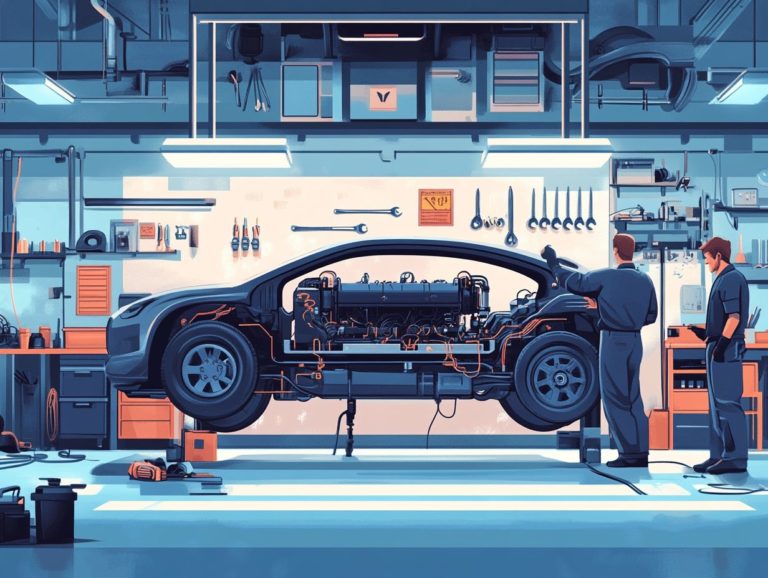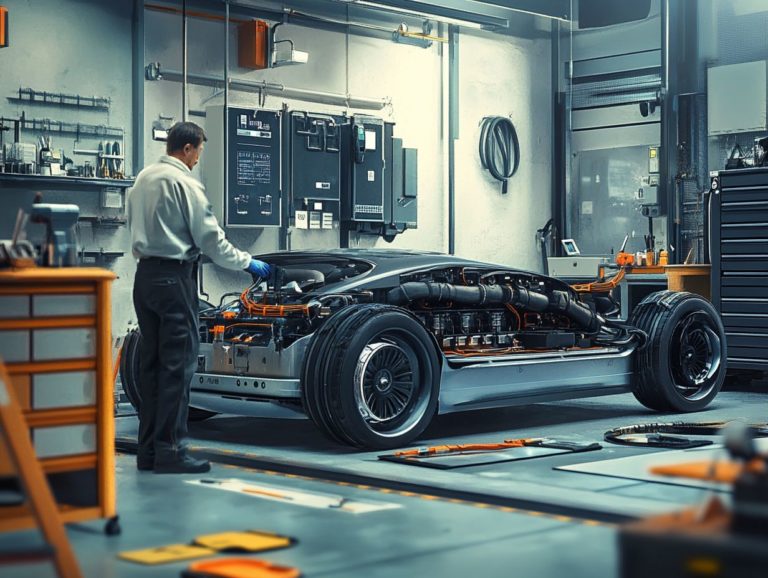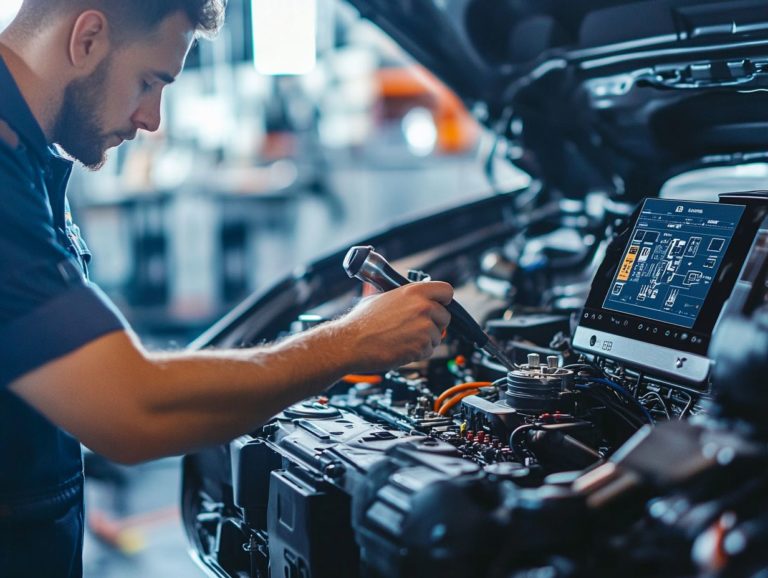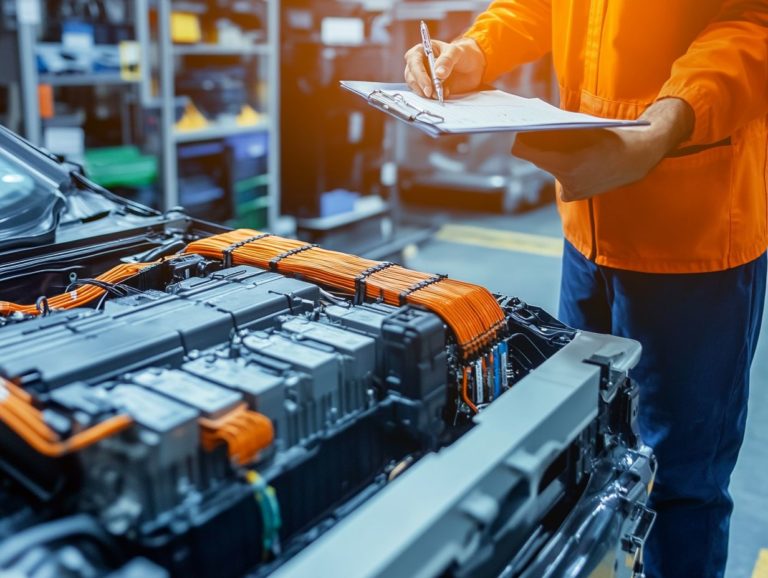How to Clean Your EV’s Engine Compartment
Keeping your electric vehicle’s engine compartment pristine is vital for achieving optimal performance and longevity. A well-maintained engine can help prevent potential issues, boost efficiency, and enhance safety.
This guide provides you with the necessary tools and materials, outlines a step-by-step cleaning process, and offers maintenance tips to ensure your engine remains in peak condition. Essential safety precautions will be emphasized, allowing you to navigate the process with confidence and ease.
Get ready to give your EV the top-notch care it deserves! A clean engine compartment not only looks great but keeps your ride running smoothly.
Contents
- Key Takeaways:
- Materials and Tools Needed
- Step-by-Step Guide to Cleaning
- Tips for Maintaining a Clean Engine Compartment
- Ensuring Safety While Cleaning
- Frequently Asked Questions
- What is the recommended frequency for cleaning my EV’s engine compartment?
- Can I use any cleaning products to clean my EV’s engine compartment?
- How do I prepare my EV’s engine compartment for cleaning?
- Can I pressure wash my EV’s engine compartment?
- How do I clean my EV’s engine compartment without using water?
- Is it necessary to clean the engine compartment of my EV?
Key Takeaways:
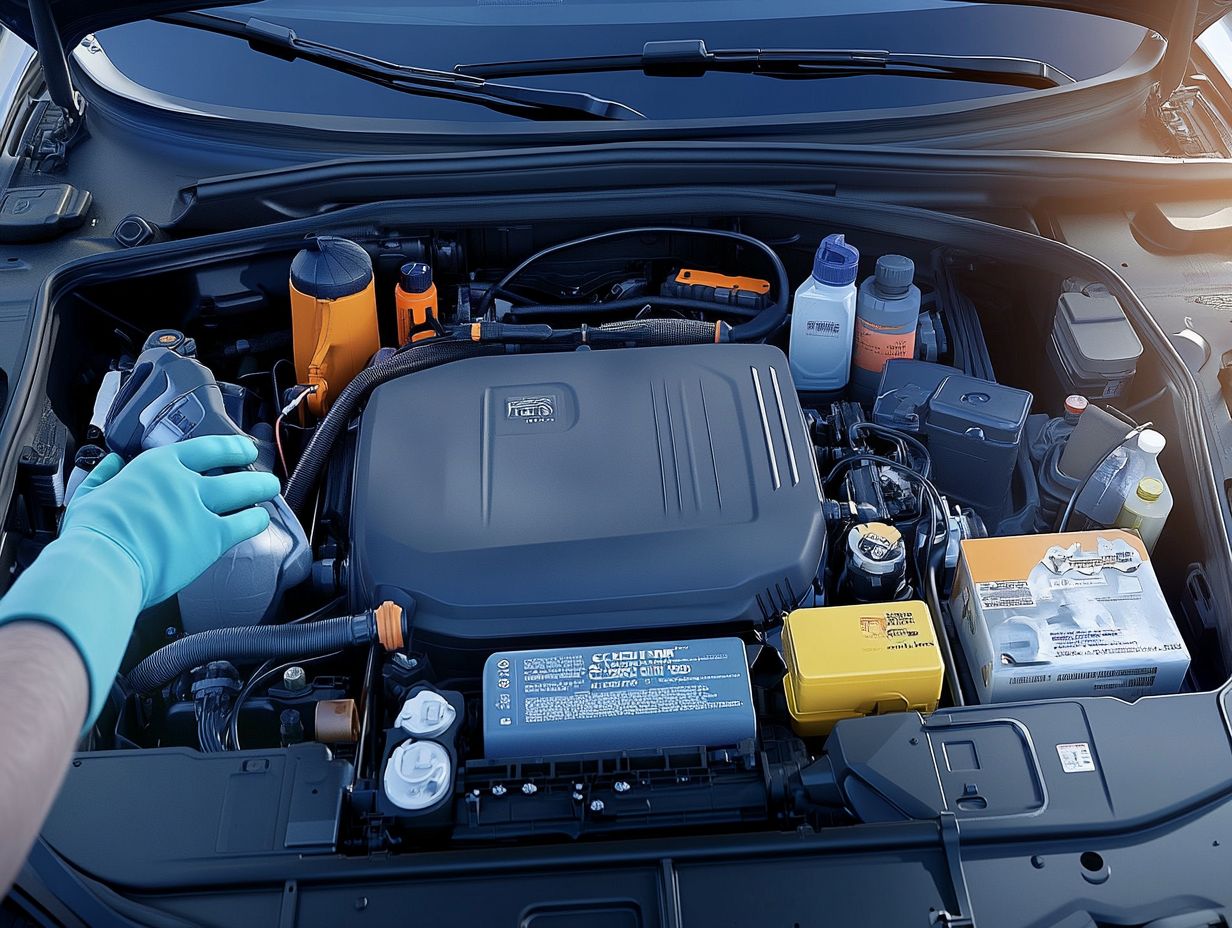
- Regularly cleaning your EV’s engine compartment is important for maintaining its performance and longevity.
- Gather necessary supplies and carefully follow a step-by-step guide to properly clean the engine compartment.
- Maintain a clean engine compartment by regularly cleaning and avoiding common mistakes while ensuring safety by taking necessary precautions.
Why is it Important?
Understanding the significance of maintaining a clean engine compartment goes beyond mere aesthetics. It is crucial for the overall performance and longevity of your vehicle.
When you regularly clean and care for your engine components, you elevate the appearance of your vehicle. More importantly, you prevent issues related to dirt and grime buildup that can adversely affect critical parts like the motor.
This practice is particularly vital for creators and YouTube influencers focused on automotive content. It enhances the quality of their presentations while adhering to best practices regarding privacy and safety guidelines.
A clean engine ensures that all components operate efficiently, minimizing the risk of overheating and mechanical failures. Regular maintenance not only boosts performance but also extends the lifespan of essential parts, thereby safeguarding your investment.
Neglecting this aspect can lead to unforeseen hazards, such as fire risks posed by flammable substances accumulating in hidden spaces. Resources like Google and YouTube have significantly increased awareness of automotive care, providing valuable tutorials and tips for vehicle enthusiasts around the globe.
By leveraging these platforms, you can discover effective cleaning methods that enhance performance and prevent potential dangers associated with a neglected engine compartment.
Materials and Tools Needed
To achieve a meticulous clean of the engine compartment in your MG ZS, you’ll want to gather a few essential materials and tools that will allow you to perform the task thoroughly while safeguarding vital components.
A powerful pressure washer will be your best ally for optimal dirt removal. Complement this tool with specialized cleaning solutions that are safe for car surfaces.
Having a selection of hand tools will enable you to access tight spots and navigate around various motor components with ease. By assembling the right items, you ll streamline your cleaning process, enhancing both efficiency and effectiveness.
Gathering the Necessary Supplies
Gathering the right supplies for cleaning your engine compartment is essential for an efficient and effective process. Start by collecting top-notch cleaning materials, such as engine degreasers, microfiber cloths, and brushes.
You might also want to add a soft-bristle brush for those delicate components, while a plastic scraper helps tackle stubborn spots without causing damage. Don t forget a bucket to mix your cleaning solutions effectively.
Each of these tools plays a crucial role: the degreasers break down that stubborn grease, while microfiber cloths ensure no scratches mar the surfaces. Ultimately, having the right selection of supplies means you ll be able to attend to every nook and cranny, resulting in a clean engine compartment that enhances performance and extends its longevity.
Step-by-Step Guide to Cleaning
Cleaning your engine compartment is a meticulous endeavor that truly benefits from a structured, step-by-step approach. This ensures that every component receives the attention it deserves.
- Start by preparing your workspace and gathering all the necessary tools and cleaning solutions.
- Then, take your time to remove any debris and cover sensitive components to protect them from water and cleaning agents.
- After that, use your pressure washer to gently rinse the motor and surrounding areas. Take care to select the right cleaning solutions that will effectively lift dirt without damaging any parts.
- Finally, conduct a thorough inspection to identify any areas that may need extra attention or care.
Preparing the Engine Compartment
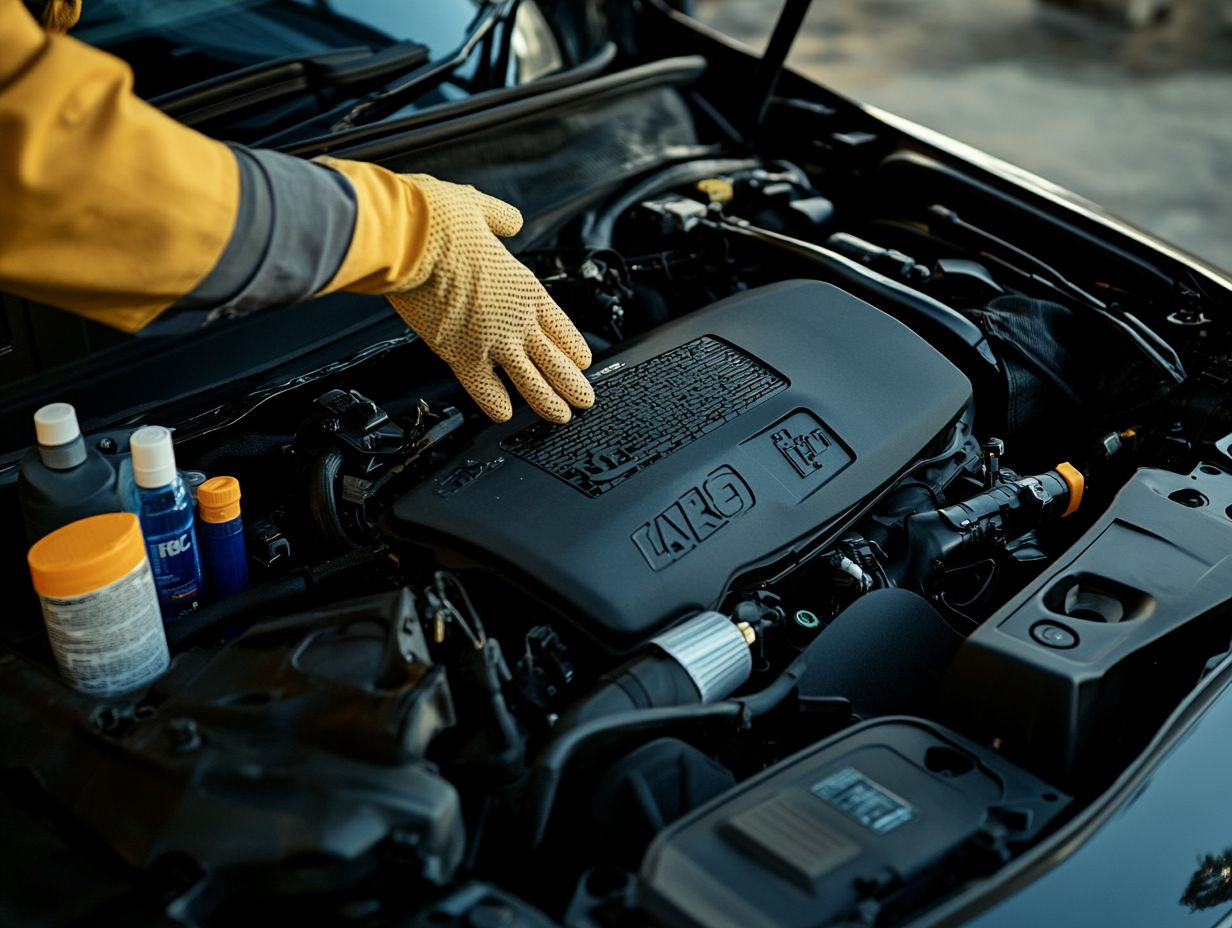
Preparing the engine compartment for cleaning is a crucial step that lays the groundwork for a successful outcome. Begin by parking your vehicle in a safe, well-ventilated area, ideally out of direct sunlight.
Next, take a moment to thoroughly inspect the space. Use soft brushes or vacuum attachments to delicately remove any stubborn dirt or grime hiding in those hard-to-reach corners. Maintaining a clean working environment is vital; this prevents any contaminants from finding their way back into the motor.
Don’t forget to protect those sensitive components, such as sensors and wire connections, by carefully covering them with appropriate materials. This attention to detail preserves the integrity of these parts and enhances the effectiveness of your cleaning efforts.
Cleaning the Engine Components
Cleaning the engine components is one of the trickiest parts of the process, demanding your utmost attention to ensure that every piece is restored to its prime condition.
To achieve optimal results, select a cleaning solution specifically formulated for the materials in your engine. For instance, use a special cleaner that removes oil and grease on stubborn buildups, especially in areas like the oil pan and valve covers.
When you apply the cleaner, use a soft-bristled brush to agitate the grime and reach those tricky spots. After giving the cleaner sufficient time to break down the deposits, it’s time to bring in the pressure washer.
Aim the nozzle carefully, directing the water flow away from sensitive components like sensors and wiring. This way, you can keep critical parts like the cooling fan and belts intact and functional. Taking this meticulous approach results in a cleaner engine and safeguards against potential damage during the cleaning process.
Drying and Finishing Touches
After you’ve thoroughly cleaned the engine components, the next crucial step is to ensure everything is properly dried and finished for optimal performance. Grab some microfiber cloths and wipe down all surfaces, eliminating moisture from every corner of the engine compartment especially around those sensitive components and connectors.
Once everything is dry, think about applying a protective dressing to the rubber and plastic parts. This helps maintain their condition and prevents cracking.
These finishing touches enhance both the appearance and longevity of your engine compartment, making your hard work truly worth it.
This drying process isn’t just a routine chore; it’s essential in safeguarding the integrity of critical engine components. By paying close attention to every nook and cranny, you significantly reduce the risk of corrosion and electrical issues that can result from lingering moisture.
Plus, when you apply a high-quality protective finish, you create a barrier against environmental factors, ensuring that rubber hoses and plastic fittings resist fading and degradation over time.
This maintenance keeps your engine looking great and works wonders for how it runs!
Get started today and give your engine the care it deserves!
Tips for Maintaining a Clean Engine Compartment
Maintaining a pristine engine compartment demands regular attention. Here are essential tips that can save you time and enhance your vehicle’s longevity.
Schedule routine inspections and cleanings to prevent dirt buildup. Use car cleaning products specifically crafted for automotive needs. This ensures effective cleaning while safeguarding your components from potential damage.
Document your cleaning regimen. This helps you track your engine’s condition over time and highlights any improvements or changes that may need your attention.
Regular Cleaning and Maintenance
Regular cleaning and maintenance of your engine compartment are essential. They prevent the accumulation of dirt and grime, which can lead to performance issues over time.
Incorporating routine inspections into your maintenance schedule can help you catch potential concerns early. If you often drive in challenging environments like rough terrains or rainy conditions pay extra attention to the engine area.
Creating a personalized cleaning schedule helps ensure your vehicle remains in optimal condition. Mark your calendar for these tasks alongside routine oil changes to keep everything on track.
Utilizing specialized car cleaning products can significantly enhance the effectiveness of your cleaning efforts.
Ultimately, a clean engine not only performs better but also contributes to the overall longevity of your vehicle, safeguarding your investment.
Common Mistakes to Avoid
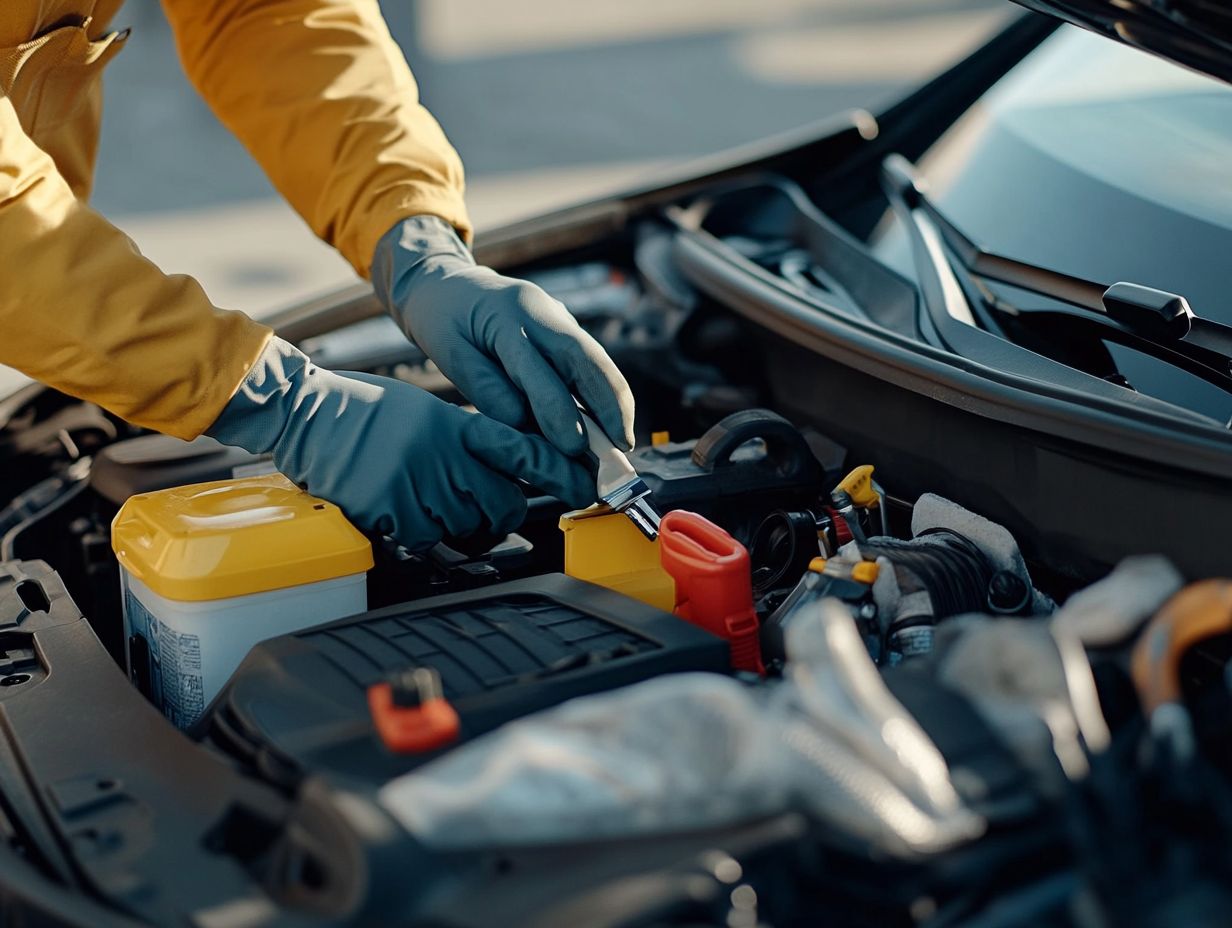
Avoid common mistakes while cleaning your engine to keep it running smoothly! One significant blunder is neglecting to cover sensitive electrical components. This can lead to electrical failures or shorts.
Using harsh cleaners can damage rubber and plastic parts. If you don t allow adequate drying time, moisture can build up, resulting in corrosion or even mold growth.
Take these precautions seriously. They are vital for your engine’s performance. When tackling this task, prioritize using protective coverings for wiring and sensors, and choose mild, non-corrosive cleaners designed specifically for automotive use.
Conduct a thorough inspection after the cleaning process. Ensure no moisture remains trapped in the engine bay. Giving the engine ample time to dry completely can significantly reduce the risk of long-term damage and help preserve your vehicle s reliability.
By following these practical tips, you can ensure a safer and more effective cleaning experience for your engine. Start your next cleaning routine today!
Ensuring Safety While Cleaning
Ensuring safety while cleaning your engine compartment is crucial. This task can pose several hazards if not approached with care.
Before you begin, don the appropriate personal protective equipment like gloves and goggles to safeguard yourself from cleaning chemicals and potential debris.
Moreover, disconnecting the battery is wise to prevent any electrical shocks. Covering sensitive components will help avoid water damage. By taking these precautions, you create a safe environment for yourself and your vehicle while undertaking this vital maintenance task.
Precautions to Take
Taking the right precautions during engine cleaning can significantly reduce risks and enhance your safety. Always ensure the vehicle is turned off and cool before diving into the cleaning process.
This approach not only protects you but also helps maintain the vehicle’s integrity. It’s wise to let the vehicle sit for a while to check its temperature; this minimizes the risk of burns from hot components.
Securing loose parts like wires and covers prevents accidental dislodging during vigorous cleaning. Be sure to use cleaning solutions specifically designed for automotive use to avoid damaging delicate parts.
Employing a gentle rinse technique helps keep water from entering vital electrical components, ensuring a safe and thorough cleaning experience.
Frequently Asked Questions
What is the recommended frequency for cleaning my EV’s engine compartment?
Clean the engine compartment of your EV every 6 months or 10,000 miles, whichever comes first.
Can I use any cleaning products to clean my EV’s engine compartment?
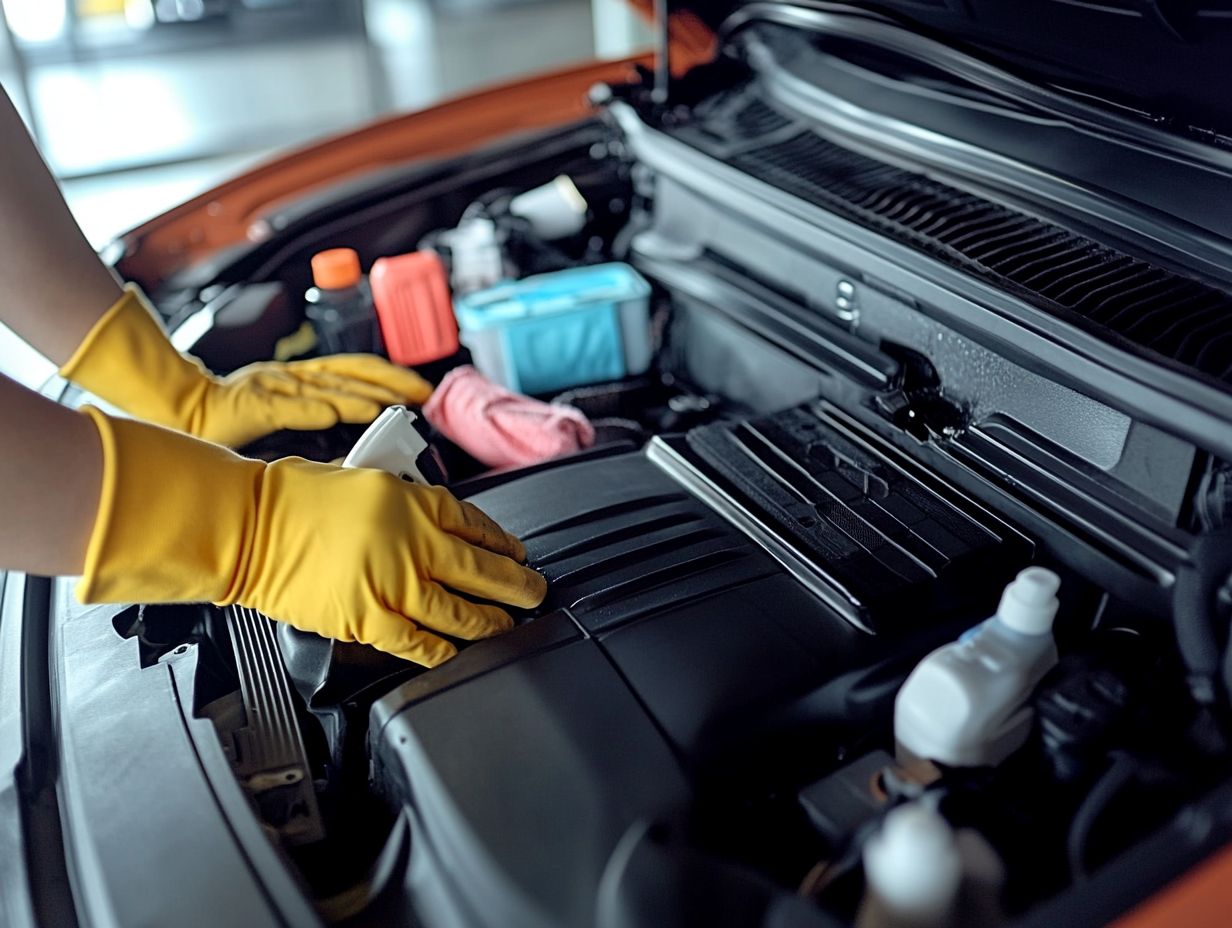
Use only cleaning products made for EVs to avoid damage.
How do I prepare my EV’s engine compartment for cleaning?
Before cleaning, make sure your EV is turned off and the engine compartment is cool. To ensure proper care, refer to guidelines on how to maintain your EV’s exterior finish and cover any delicate electrical components with plastic bags or towels to keep them dry.
Can I pressure wash my EV’s engine compartment?
It’s not recommended to use a pressure washer on your EV’s engine compartment, as the high pressure can damage delicate parts and cause water to seep into electrical connections.
How do I clean my EV’s engine compartment without using water?
You can use a non-water-based engine cleaner and a microfiber cloth to wipe down the engine compartment. Follow the instructions on the cleaner carefully.
Is it necessary to clean the engine compartment of my EV?
Yes, regular cleaning helps prevent dirt and debris buildup that can affect your EV’s performance. It also allows for easier maintenance and inspections.

